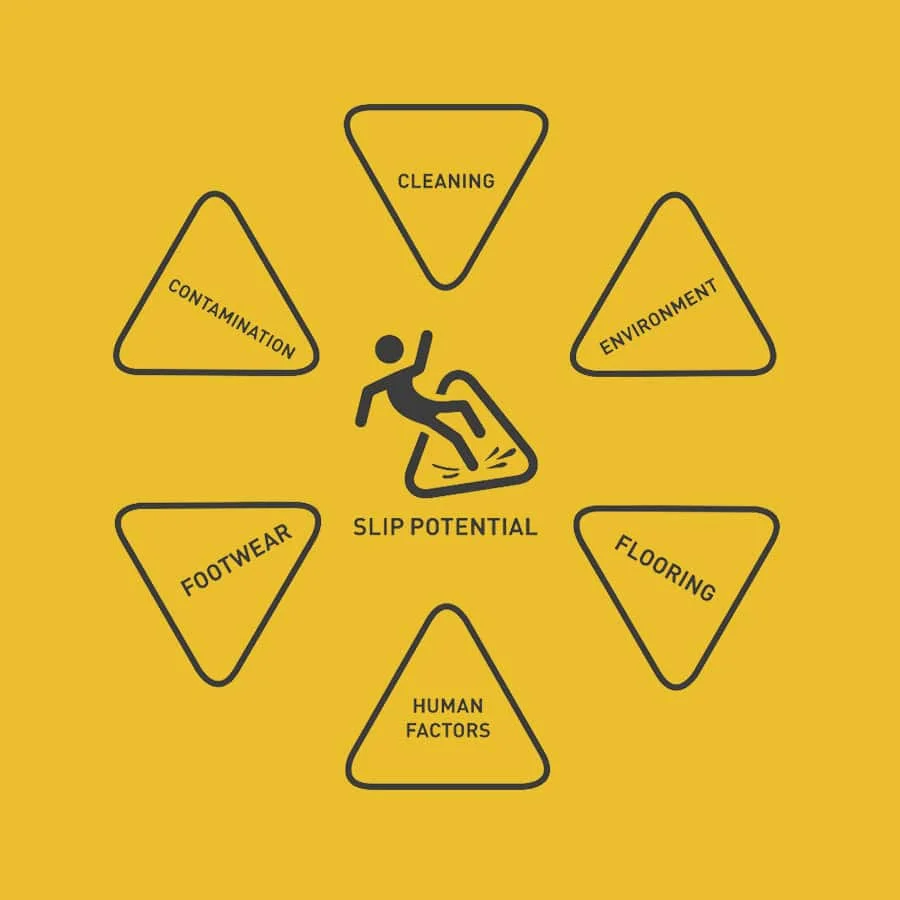Pendulum Slip Testing
What is a pendulum test?

The pendulum test uses an instrument known as a pendulum skid resistance tester to measure the dynamic co-efficient of friction. This is the friction available between two objects when at least one of them is moving. This measurement is used to determine the slip resistance of a floor surface.
So what is a Pendulum Slip Test?
Measuring the Dynamic Coefficient of Friction (CoF) using a Pendulum Tester is the HSE’s original slip resistance testing method in the UK. It is one of two methods recognised by the HSE and considered the most effective form of testing to determine whether floors are fit for purpose. (The other method is the SlipAlert)
The Pendulum is subject to European Standard BS EN 16165 and British Standard BS 7976, BS EN 13036-4:2003 and should be operated in accordance to these standards and the UK Slip Resistance Group Guidelines Issue 5 (2016). This is the UK HSE and UKSRG preferred in-situ slip test method.
The Pendulum Slip Test is recommended by the HSE as a ‘reliable and accurate test’ when operated by ‘a suitably trained and competent person.’
As a fully portable test, it allows precise locations to be slip tested i.e. the site of a fall. The test is reliable and efficient and most organisations find that it can be carried out with minimal disruption to their business.
The Rz Surface Roughness test measures the surface roughness and should be taken in support of a pendulum assessment as it can provide additional information about a floor surface and its ability to cope with contaminants.
The combination of the tests is recognised as providing the most accurate measure of pedestrian slip resistance of a surface in-situ.
All test equipment carries the appropriate UKAS calibration certification.
How Does the Pendulum Tester Work?
The Pendulum Test measures the slip resistance of a floor surface by replicating the interaction between a moving pedestrian heel and static surface.
The Pendulum has a swinging arm with a rubber slider attached to the heel of an imitation foot, which sits at the bottom of the arm. The slider imitates the heel of a shoe or a barefoot. When the arm is released, it swings downwards building momentum, before the heel strikes the floor surface. The arm slows in accordance to the amount of friction available and will continue to travel until it runs out of momentum.
A needle will record the point where the momentum is completely lost and determine the amount of friction available to the slider from the floor surface which gives an indication of slip risk. Measurement is given in PTV (Pendulum Test Value).
Results showing a Pendulum Test Value of 36+ are considered to have a low slip potential, with moderate scores ranging from 25-35 and high slip potential scores being between 0 and 24.
Measurements are taken in three different directions, along the direction of travel, across the direction of travel and diagonally across the direction of travel. It is important to take these three directions to monitor things such as the wear of the floor surface or the impact the grain direction or texture of the floor surface may have in relation to the friction available.
Once we have these measurements we can use this information along with elements from the Slip Potential Model, the HSE’s SAT assessment tool and our environmental summary to understand the factors contributing to slip risk.
Pendulum tests are regularly used in court proceedings where slip injury claims are considered, thereby ensuring that the employer/owner can demonstrate a clear duty of care and provision of a safe environment. The key to improving claims defensibility is to build a picture of this data over time, to demonstrate reasonable measures are being taken and processes in place to ensure the safety of all floor users.

Should a Pendulum Test be carried out in wet or dry conditions?
The Pendulum test is very accurate and adaptable, allowing for results to be shown for wet and dry conditions. Although the common expectation is for a floor surface to perform well in the dry, it is really important to understand the slip risk when wet too. In most circumstances the floor surface will record a lower slip resistance in the wet and therefore record an increased slip risk. In order to demonstrate that you have fulfilled your duty of care and taken all reasonable measures it is vital to test in both wet and dry conditions.
The needle will record how much momentum is lost and therefore the amount of friction available to the slider from the floor surface which gives an indication of slip risk.
Did you know?
So far this year slips have cost society at least:
50%
of all accidents to the public are slips and trips.
Hi, I’m Harry, and I’ve been with SlipTest nearly six years now working with our customers to improve their floor safety, reduce their slip risk and trying
to prevent incidents from happening.
One of the pieces of equipment that we use on a regular basis with our customers is the pendulum which you can see here and I’m going to give you a very basic demonstration on the machine today and how it works.
So, we’ve got the machine set up on a floor here, on a typical pedestrian type floor and we can see the method in which the pendulum works in that there’s a rubber footer attached to the bottom of the machine here and that’s to replicate the heel of a shoe this particular slider is slider 96 which is kind of the short pedestrian footer that we would generally use for most of our testing. There is a slide of 55 which is used for barefoot testing and there’s the odd scenario where you might need to test for short pedestrian and barefoot.
Slider 96, we are using today on the pendulum and the slider is attached to an imitation shoe essentially, which contacts the floor for a pre-determined distance before kind of activating the needle and measuring our slip resistance. This machine has been set up properly, it’s calibrated the slider has been prepared and so let’s get to testing.
It’s important to remember that when we let the shoe go and we push the button here, we must catch it before it returns. Here we go, so we’ve registered 62 PTV (Pendulum Test Value) and our 62 PTV is a good slip resistance, this is categorised as a low risk of slip and we use this is the kind of scale for measuring slip resistance.
Anything which is 36 or above is deemed as a low risk of slip, at that point, one in one million people may find that the floor feels slippery under foot. When we come down to 24 PTV and that’s kind of the bottom of a high risk of slip, so anything less than that is deemed as a high risk of slip. At 24 it’s about 1 in 20 people may find that the floor feels slippery under foot and that gap in between, 24 to 36, that’s our moderate risk of slip.
It’s important to ensure that we’re testing our floors in both wet and dry conditions, the British standard calls for it, but also we find that more incidents and accidents occur when there is some form of contamination involved. Generally, we would use water (to test wet), however if there are specific contaminants in your property, oils, fluids, fats or greases, then we can test to replicate the environment that may well be in your properties.
So, what I’m going to do this time is, we are just going to use some water and we thoroughly wet our test area, there we go, and then the same principle as before we reset our needle and away we go. So, we can see now that the floor has achieved 34 PTV in wet conditions, so it’s just fallen into the moderate risk of slip but for this type of flooring it’s a pretty good measurement and we would be would be fairly happy with that and given the fact that this floor is quite unlikely to become that wet and then, yeah we’d be perfectly happy with that floor.
So that’s the pendulum and as I say a nice piece of kit to use, takes some expertise and some training to use properly and set up and ensure that we’re getting accurate results and but it’s just one of the pieces of kit that we use here at SlipTest.



